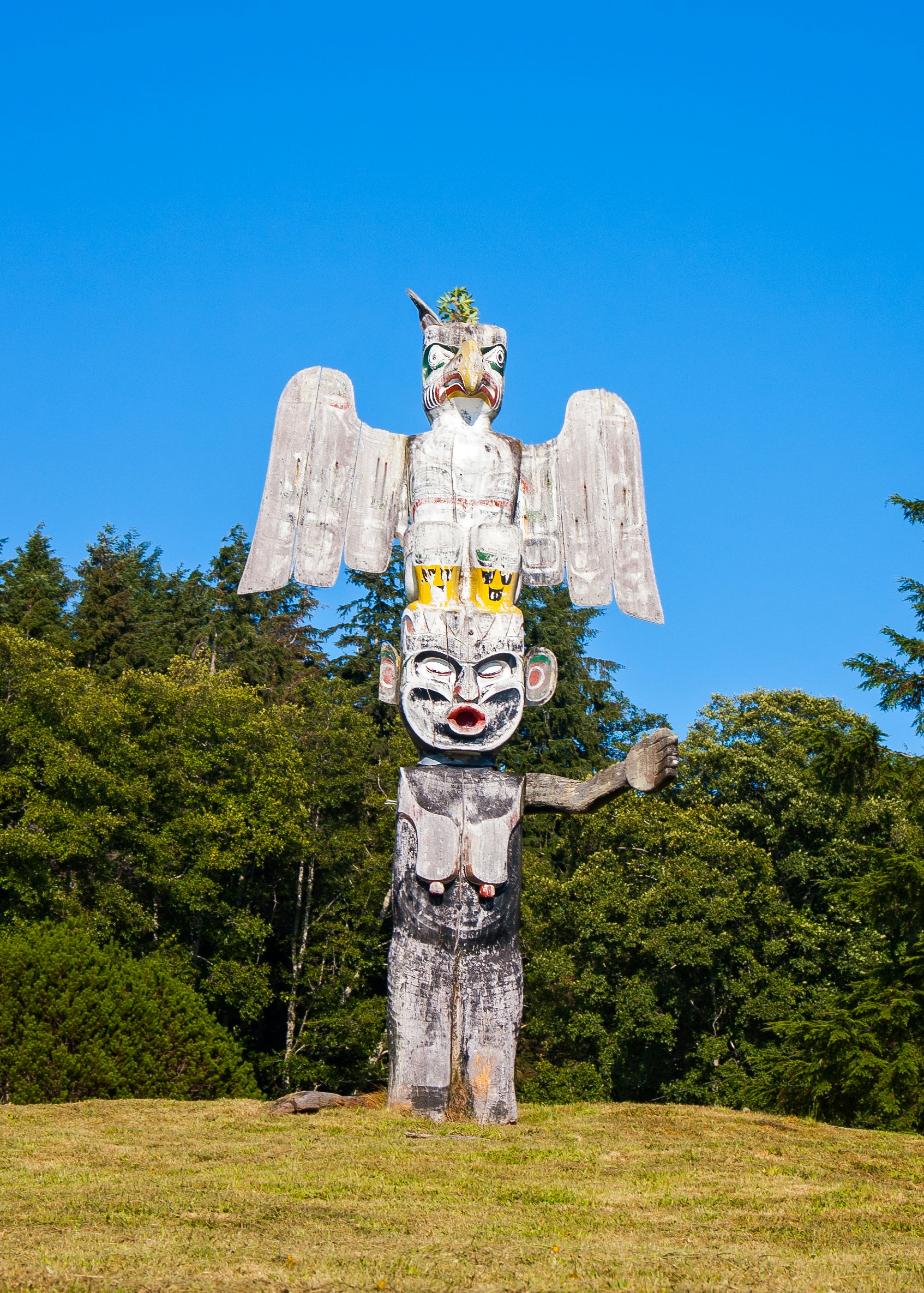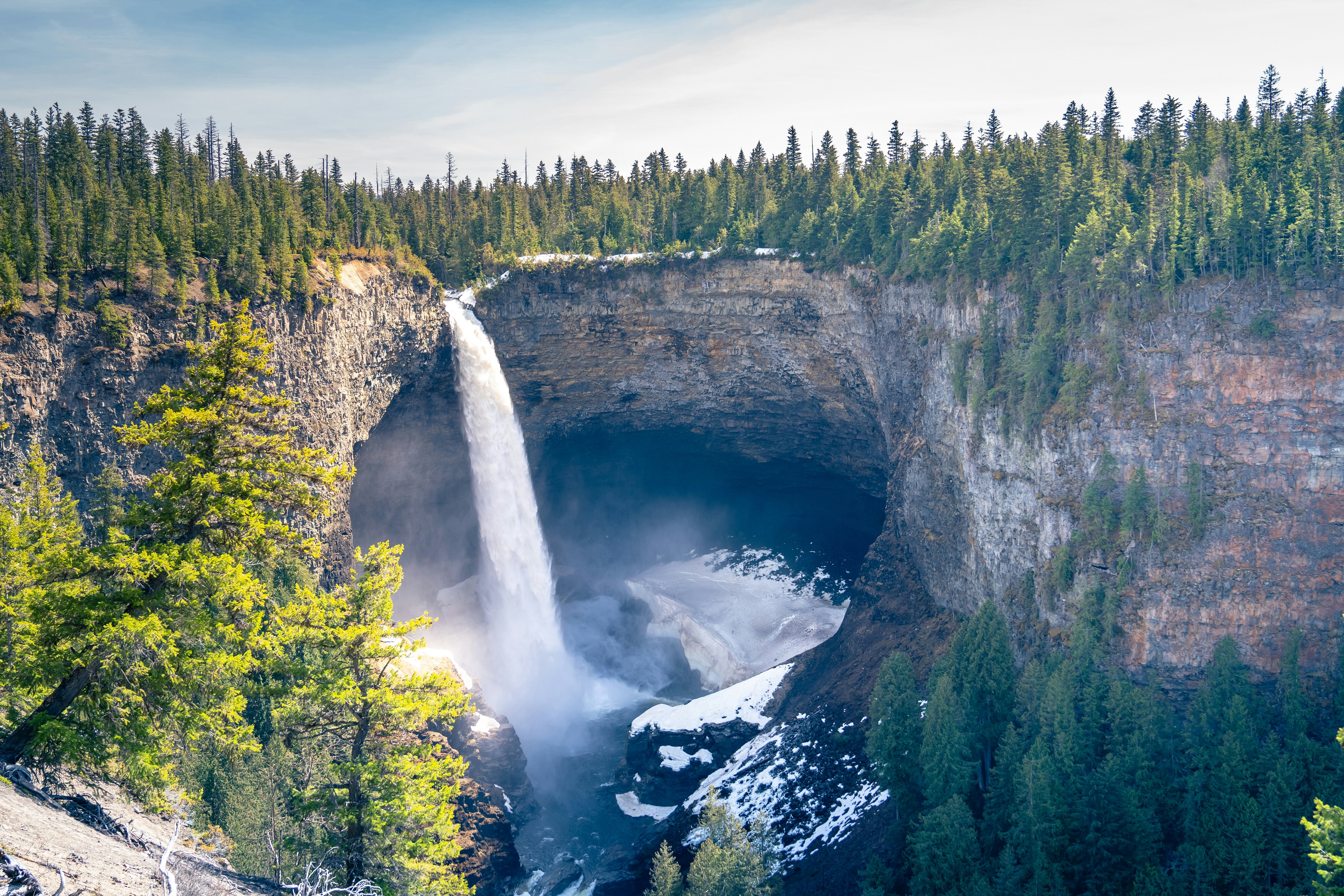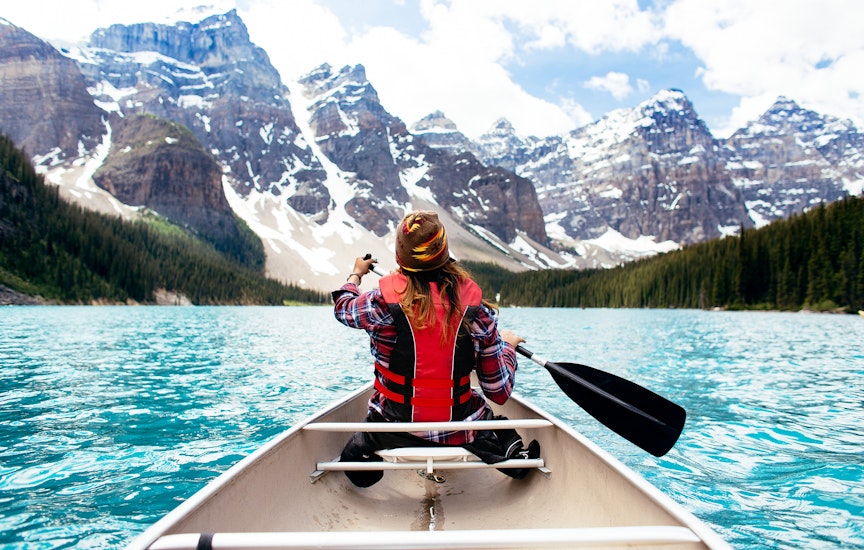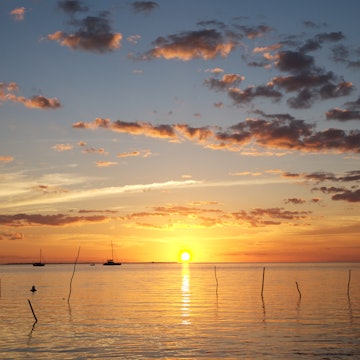

Experiencing the best of British Columbia (BC) is all about getting outdoors in nature. EB Adventure Photography / Shutterstock
With its formidable mountain ranges, city-sized glaciers and vast food-chain of fauna, travel in British Columbia (BC) is less about wandering around museums and churches and more about exploring its rugged natural environment with crampons, pedals, oars, skis, climbing equipment, or hiking paraphernalia.
There are innumerable places to witness this outdoor theatre, plus plenty of towns and cities to recharge your energy afterwards.
If your focus is narrow, select a destination based on your preferred activity: Whistler for skiing, Tofino for surfing, Osoyoos for wine-tasting, and so on. For more all-encompassing trips, try planning an itinerary around one or more of the recommended destinations below. Just remember, BC is large. You’ll struggle to see it all in a year, let alone a month.

1. Tofino
Best for surfing
On stormy days, the choppy waters of the Pacific Ocean unleash their pent-up rage on the misty beaches of Tofino on Vancouver Island providing a perfect playground for ambitious surfers. A long line of forest-backed beaches stretches north-south between Tofino and its coastal twin Ucluelet and is connected by both road and a multi-use path.
The town at the center of it all, Tofino (population 2000-ish), contrasts its rugged location with a mellow surfer vibe: think farm-to-table restaurants, woodsy brewpubs and 70s retro hotels. While surfing is its underlying appeal, the area is also revered for whale-watching trips (gray and humpbacks are common), sea-kayaking in sheltered Clayoquot Sound, and natural hot springs reachable on organized boat trips.
Planning tip: The sea is cold year-round: rent a wetsuit with your surfboard or bring your own.
2. Campbell River
Best for diving
While Campbell River on Vancouver Island has long been known for its historic Tyee fishing club, it is also the location of the best diving on Canada’s west coast courtesy of the strong tidal currents and cold, oxygen-rich seas of adjacent Discovery Passage. The upshot? Excellent water clarity and perfect growing conditions for a rich variety of giant subaquatic plants and marine life. You can navigate your flippers around forests of tall bull kelp and train your mask on splashes of vivid strawberry anemone, as you look out for giant Pacific octopus and explore the phantasmic remains of several wrecks, including the of HMCS Columbia, a 1950s-era destroyer that was sunk to serve as an artificial reef in 1996.
Local tip: Organize your underwater excursions with Oceanfix, the best local dive operator with 40 years of experience.

3. Alert Bay
Best for Indigenous culture
Located on Cormorant Island just off the northeastern shores of Vancouver Island, Alert Bay is a small village-sized settlement embellished with a pretty arc of harborside buildings, many of them raised on stilts above the water. It’s also home to a robust Indigenous community. This is the ancestral home of the Namgis First Nation whose historical heirlooms, contained in the so-called potlatch collection, are one of the finest manifestations of Indigenous culture in Canada.
The pieces – masks, carvings and totems - are showcased in the U’mista Cultural Centre, a unique museum whose design echoes that of a wooden longhouse and whose Kwakwaka'wakw artifacts were repatriated after being confiscated when potlatch ceremonies were prohibited in Canada in the 19th and 20th centuries. Elsewhere on the island, you can dig deeper into Indigenous culture at an original Namgis clan house, a centuries-old burial ground and what is purportedly the world’s tallest totem pole.
Planning tip: Alert Bay is a 40- to 50-minute car ferry ride from Port McNeill on Vancouver Island. See BC Ferries for schedules.
4. Yoho National Park
Best for wildlife-viewing
Canada’s second oldest national park is one of four contiguous Rocky Mountain parks that was incorporated, along with Banff, Jasper and Kootenay, into a Unesco World Heritage site in 1984. Known to geologists for its Burgess shale deposits that contain some of the oldest and rarest fossils in the world, Yoho is also heralded for its wildlife-viewing potential. Despite its diminutive size, it is home to 58 species of mammal (five more than adjacent Banff), including wolves, lynxes and big-horn sheep. For casual viewers, elk are common around the braided banks of the Kicking Horse River in the spring while black bears forage in the bushes abutting Emerald Lake.
Planning tip: Melding beautifully with its surroundings, the Emerald Lake Lodge sits on five acres of prime Yoho real estate beside its blue-hued namesake. Book well in advance.

5. Osoyoos
Best for wine-tasting
Osoyoos, wedged up against BC’s southern border with the US, has several feathers in its tourist cap, including baking hot summers, a superb recreational lake, golf courses in abundance, and a key role in BC’s rising reputation as an international wine destination.
The province currently has five recognized viticultural areas and Osoyoos lies in its largest pocket, the Okanagan Valley. With its warm summer climate and low precipitation giving the landscape a tangible desert-like appearance, the small town is renowned for its red wines, headlined by sun-ripened Syrahs, Merlots and Cabernet Sauvignons.
Of its assemblage of wineries, head to lakeside LaStella, 4 km northwest of Osoyoos, whose terra-cotta roof tiles appear like a vision of rural Italy. The winery’s Merlot–based Maestoso – as the name implies - will have you humming majestic pieces of music.
Local tip: Be sure to also check out Nk’Mip Cellars, North America’s first Indigenous owned winery on the eastern side of Osoyoos Lake.

6. Whistler
Best for skiing
Thanks to its size, accessibility, and variety of terrain, Whistler makes a strong case for being the finest ski resort in North America. It’s certainly the largest with 3307 hectares of skiable terrain spread over two mountains (Blackcomb and Whistler) handily linked by a 4.4km peak-to-peak gondola. At the foot of the slopes lies an attractive resort village beautified by Bavarian-meets-West-Coast architecture that’s arranged around a pedestrianized main street. In recent years, Whistler has successfully broadened its image to include adventurous summer activities like downhill mountain biking, lake swimming and world-class golf. It has also morphed, somewhat improbably, into an art center spearheaded by the Audain Art Museum, one of the best galleries in the province that’s noted for its high caliber Indigenous mask collection.
Local Tip: Ski late in the season for less crowds. One of Whistler’s two mountains always remains open until mid- to late-May.

7. Vancouver
Best for Asian cuisine
To say that Vancouver is an obligatory stop on any BC itinerary would be stating the obvious. Most visitors start their BC adventures at YVR airport, and few can resist an elongated look at the metropolis that regularly features in lists of the world’s most livable/beautiful/sustainable cities. Famous Vancouver icons include salubrious Stanley Park, the gondola-accessible North Shore Mountains, historic Chinatown and farm-to-table focused Granville Market. Much newer in provenance, but equally compelling is the food scene, a lot of it driven by the taste and talents of new immigrants particularly from southern and eastern Asia. You can enjoy BC sushi rolls (containing barbecued salmon and cucumber) in various haunts in trendy Yaletown, sample Indian fusion at Vij’s in the Mount Pleasant neighborhood, or travel around the culinary world in one street, cosmopolitan Denman Street, in the city’s West End.
Planning tip: Come in late-January or early-February for the annual Dine Out Vancouver festival when over 400 restaurants showcase fixed-priced menus that celebrate local food.

8. Golden
Best for outdoor adventure
A diminutive mountain town set in the shadow of the Purcell range; Golden has refined its tourist infrastructure in recent years to become an all-season activity hub to rival Whistler. The prime attraction is Kicking Horse Mountain, a winter ski resort with a hardcore reputation which, come summer, transforms into a mix of bear refuge, bike park, and network of exhilarating via ferrata (fixed climbing) routes.
Turning the volume up to 11 is the new-ish Golden Skybridge, another adrenalin-fueled activity area consisting of Canada’s highest suspension bridge, a 300m-long zipline, a mountain coaster ride along the canyon rim, and a canyon swing that pitches you trapeze-like over a gaping chasm.
Beyond these two hair-raising hubs, Golden has also fermented a reputation for its long flowing mountain biking trails and choppy whitewater rafting on the class V rapids of Kicking Horse River.
Local tip: For the best views of the Purcell Mountains, take Kicking Horse’s Golden Eagle Express gondola to the top station and walk the one-hour (return) Terminator Ridge trail.

9. Wells Gray Provincial Park
Best for waterfalls
This underappreciated provincial park tucked 123 km north of Kamloops on Hwy 5, is the fourth-largest park unit in BC. Established in 1939 and framed by the Clearwater River and its tributaries, it’s bigger than all seven of the province’s national parks, and equally majestic. The reason? Five substantial lakes, two giant river systems, plenty of opportunities for hiking, cross-country skiing and horseback riding, and the trump card: waterfalls, headlined by mighty Helmcken Falls, Canada’s fourth highest cascade that funnels its powerful flume 141m onto the slippery rocks below.
Planning tip: The park’s main hub is the town of Clearwater, on the Kamloops-Edmonton Ebus route, where you can pick up info on hiking, skiing and riding along more than 20 varied trails.
10. Squamish
Best for rock-climbing
Squamish is a town on the rise, well-known among people of an adventurous spirit for its rugged mix of mountain biking, kitesurfing and rock-climbing. The latter activity (arguably its most emblematic) is courtesy of the Stawamus Chief, the town’s giant granite sentinel that offers an open invitation to anyone who has ever rubbed chalk on their hands and nailed a ring bolt into a cliff-face.
The Chief’s 700m-high sheer face is lauded all over North America for its vertical walls, tricky cracks and immense slabs that make it perfect for every style of rock-climbing. Keen hikers can also summit the rocky monolith on a steep walking trail, aided by wooden stairs, that starts from Squamish’s gondola station beside the Sea-to-Sky highway.
Local Tip: For a less precarious fixed-protection climbing experience, book a guided via ferrata climb with Mountain Skills Academy at the top of Squamish’s Sea to Sky gondola.
11. Cumberland
Best for mountain biking
Cumberland, in Vancouver Island’s Comox Valley, is a one-time coal-mining settlement that faced an existential crisis in the 1960s when the mine’s closure nearly put it out of business. Reclassifying itself as a village, the economy was rejuvenated by a group of foresighted mountain bikers who, after reaching an agreement with local lumber companies, built a network of 170 biking trails in the surrounding community forest. As the town began attracting bike tourists and its reputation grew, Cumberland turned its downtown buildings into independent shops, brewpubs, cafes, hostels and rental outlets, without forgetting its mining-era history which has been preserved in a museum and a handful of handsome heritage buildings. Today, it styles itself as a “village in the forest” feted for both its recreational present and industrial past.
Local Tip: Stay at the Cumberland hostel, Riding Fool, run by local bike experts with an excellent rental outlet Dodge City Cycles situated next door.

12. Sunshine Coast
Best for hut-to-hut hiking
Disconnected from the provincial road network, the insular stretch of shoreline north of Vancouver known as the Sunshine Coast is easily accessible by regular ferry. Aside from generous amounts of solar rays, the region is heralded for its historic company town heritage (in Powell River), kayaking, tidal rapids, and long-distance hiking opportunities. Rather like the eco-cyclists in Cumberland on Vancouver Island, proactive community activists in Powell River came together in the early 1990s to build a 180 km hiking trail through tracts of old growth forest that fringe the region’s coastal fjords. The so-called Sunshine Coast Trail (SCT) is uniquely sprinkled with 16 volunteer-built huts located less than a day’s walk apart, offering hikers free overnight accommodation on a first-come-first-served basis. Snaking across forested mountain foothills past a network of placid freshwater lakes, it is the longest hut-to-hut hike in Canada.
Planning tip: You don’t have to do the whole 180 km in one go. See the SCT website for shorter suggestions, including day-hikes.
















